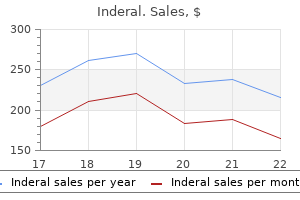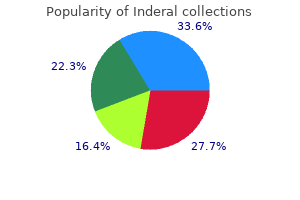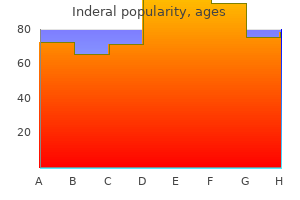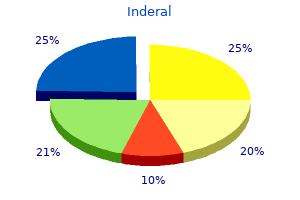Inderal

"Inderal 10mg on-line, prehypertension yahoo".
W. Lukjan, M.S., Ph.D.
Deputy Director, Jacobs School of Medicine and Biomedical Sciences, University at Buffalo
Nephrotoxicity in diabetics given aminoglycosides is a concern heart attack left arm purchase 10 mg inderal, so ceftazidime has been given as monotherapy blood pressure medications cheap 80mg inderal overnight delivery. Fluoroquinolones arteria femoralis generic inderal 80 mg fast delivery, primarily ciprofloxacin blood pressure headaches 80 mg inderal visa, can be given orally with excellent cure rates, but again, concerns of drug resistance have arisen. The endpoint of therapy is individualized with gallium scanning, and treatment courses have been documented to run several months. N Outcome and Follow-Up With proper diagnosis and treatment, cure rates are over 80%. Thresholds represent the softest sound audible at least 50% of the time measured in decibels. Immittance testing assesses the status of the middle ear and acoustic reflex pathways. Approximately 314 in 1000 people over age 65 have hearing loss, as do 40 to 50% of people over age 75. N Clinical Signs and Symptoms Persons with hearing loss frequently report difficulty hearing in background noise. They often need the television volume louder than is comfortable for others and ask for things to be repeated. Differential Diagnosis Results of audiometric testing are typically plotted on an audiogram. An audiogram is a graph with frequency (in Hz) plotted on the x axis and intensity (in decibels) plotted on the y axis. It is necessary to employ masking (a static type of noise) in certain situations to prevent the nontest ear from detecting the test signal. Otologic disease may be categorized as conductive hearing loss, sensorineural loss, or mixed hearing loss. The loss may be due to dysfunction involving the external canal, tympanic membrane, or ossicular chain, or middle ear fluid. A poor word-recognition score, especially out of proportion to pure tone thresholds, suggests possible retrocochlear pathology, such as an acoustic tumor. Patterns of sensorineural loss may be suggestive of certain etiologies, taken together with clinical history and exam. For example, acoustic trauma (noise-induced loss) often results in a loss centered around 4 kHz with recovery at higher frequency, i. This indicates immobility of the tympanic membrane, which may be due to fluid in the middle ear or tympanic atelectasis. G Large ear canal volume suggests patent pressure equalization tube or perforated eardrum. N Evaluation Tuning Fork Tests the goal of these tests, including the Weber test. Weber Test the Weber test will lateralize to the ear with conductive loss, if sensory hearing is equal. It usually takes about a 30-dB conductive loss to flip the tuning fork response, to bone conduction greater than air. Insert earphones placed in the ear canal are the transducer of choice in assessing air-conduction thresholds due to infection control, increased interaural attenuation, and prevention of collapsed ear canals. Conventional behavioral audiometry is conducted by having a person respond to pure tones.

The regulation eliminated a DoD-wide list of conditions that would disqualify persons from retention in military service pulmonary hypertension 60 mmhg buy inderal 80mg, including the categorical ban on open service by transgender persons blood pressure medication history inderal 10mg mastercard. This new regulation instructed each branch of the Armed Forces to reassess whether disqualification based on these conditions pulse pressure of 96 buy 40mg inderal fast delivery, including the ban on service by transgender persons blood pressure chart bottom number inderal 10 mg amex, was justified. As of August 2014, there was no longer a DoD-wide position on whether transgender persons should be disqualified for retention. In February 2015, just a few days after Secretary of Defense Ashton Carter took office, I accompanied him on a trip to Kandahar, Afghanistan, in my capacity as his chief of staff. On July 28, 2015, after consultations with the secretaries of the military departments, Secretary Carter directed Brad Carson, Acting Undersecretary of Defense for Personnel and Readiness, to convene a working group ("the "Working Group") to study the policy and readiness implications allowing transgender persons to serve openly in the Armed Forces. The Working Group was asked to start with the presumption that transgender persons could serve openly unless objective, practical impediments were identified, and to develop an implementation plan that addressed those issues with the goal of maximizing military readiness. By the time Secretary Carter directed the formation of the Working Group, I had moved out of my position in his office to become Acting Under Secretary of the Army. Subsequently, from November 3, 2015 to January 11, 2016, I served as Acting Secretary of the Army, and then as Secretary of the Army beginning May 18, 2016. The Working Group considered information from a variety of sources, including medical and other experts, drawn from both within and outside of the Department of Defense; senior military personnel who supervised transgender service members; and transgender people on active duty. The input of commanders reflected their high regard for the transgender staff serving under their command. Members of the Working Group discussed the evidence relating to the costs of permitting transgender persons to serve openly in the military, and the evidence relating to the impact of service by transgender people on operational effectiveness and readiness. Members of the Working Group noted that while transgender service members might have short periods when they were not deployable due to their medical treatment, such periods are not unusual for service members generally, who may take time off due to medical conditions or other reasons. The Working Group also considered that providing medical care for transgender individuals is becoming increasingly prevalent in both public and private sectors alike. Over a third of Fortune 500 companies currently offer employee health insurance plans with transgender-inclusive coverage. Similarly, nondiscrimination policies at two-thirds of Fortune 500 companies now cover gender identity. With respect to the public sector, the Working Group learned that all civilian federal employees have access today to a health insurance plan that provides comprehensive coverage for transgender-related care and medical treatment. Members of the Working Group also discussed the disruptive effect of banning service by transgender people, since such a ban necessitates the discharge of highly trained and experienced service members, leaving unexpected vacancies in operational units and requiring the expensive and time-consuming recruitment and training of replacement personnel. Members of the Working Group also discussed the negative impact of continuing to ban service by transgender people on overall military readiness because it reduces the pool of potential, qualified recruits for military service. At the conclusion of its discussion and analysis, the members of the Working Group did not identify any basis for a blanket prohibition on open military service of transgender people. Likewise, no one suggested to me that a bar on military service by transgender persons was necessary for any reason, including readiness or unit cohesion. The Working Group communicated its conclusions to the Secretary of Defense, including that permitting transgender people to serve openly in the United States military would not pose any significant costs or risks to readiness, unit cohesion, morale, or good order and discipline. The Working Group also agreed that the accession policy should be changed to allow transgender people to enlist. The Working Group agreed that the medical standards for accession into the Military Services by transgender persons should be based upon the same standards applied to persons with other medical conditions, which seek to ensure that those entering service are free of medical conditions or physical defects that may require excessive time lost from duty. The Working Group also provided comprehensive input regarding all aspects of implementing any change to related military policy. That included addressing practical concerns, like housing and uniform standards for transgender personnel, including when a transitioning service member should be authorized to conform to the standard of the gender to which they were transitioning. The guiding principle behind the Working Group deliberations was that all who are qualified to serve should have the opportunity to do so. The ban on transgender service members was the last categorical ban on otherwise qualified potential service members. No qualified American who can meet the enlistment and retention standards should be excluded from the opportunity to serve. Consistent with the policies and procedures set forth in this memorandum, transgender individuals shall be allowed to serve in the military. Embedded within our Constitution is that very principle, that all Americans are free and equal. Army Directive 2016-30 was effective immediately and applies to all personnel in the Active Army, U. The Army is open to all who can meet the standards for military service and remains committed to treating all Soldiers with dignity and respect while ensuring good order and discipline.

Hygromas are believed to arise from parts of a jugular lymph sac that are pinched off or from lymphatic spaces that fail to establish connections with the main lymphatic channels hypertension guidelines jnc 8 cheap 80mg inderal amex. Cystic hygroma was demonstrated from this crosssectional view of the posterior fetal neck at 18 blood pressure levels low too low order inderal 40mg otc. The lesion was characterized by multiple pulse pressure 68 80 mg inderal sale, septated cystic areas within the mass itself as shown in the pathology specimen (B) useless eaters hypertension zip inderal 80 mg with mastercard. Mesenchymal cells derived from splanchnic mesoderm proliferate and form isolated cell clusters, which soon develop into heart tubes that join to form the primordial vascular system. The heart primordium consists of four chambers: the bulbus cordis, ventricle, atrium, and sinus venosus. As the heart grows, it bends to the right and soon acquires the general external appearance of the adult heart. The heart becomes partitioned into four chambers between the fourth and seventh weeks. Three systems of paired veins drain into the primordial heart: the vitelline system, which becomes the portal system; the cardinal veins, which form the caval system; and the umbilical system, which involutes after birth. As the pharyngeal arches form during the fourth and fifth weeks, they are penetrated by pharyngeal arteries that arise from the aortic sac. During the sixth to eighth weeks, the pharyngeal arch arteries are transformed into the adult arterial arrangement of the carotid, subclavian, and pulmonary arteries. The critical period of heart development is from day 20 to day 50 after fertilization. Numerous events occur during cardiac development, and deviation from the normal pattern at any time may produce one or more congenital heart defects. Some congenital anomalies result from abnormal transformation of the pharyngeal arch arteries into the adult arterial pattern. Because the lungs are nonfunctional during prenatal life, the fetal cardiovascular system is structurally designed so that the blood is oxygenated in the placenta and most of it bypasses the lungs. The modifications that establish the postnatal circulatory pattern at birth are not abrupt, but extend into infancy. The lymphatic system begins to develop late in the sixth week in close association with the venous system. Six primary lymph sacs develop, which later become interconnected by lymphatic vessels. Lymph nodes develop along the network of lymphatic vessels; lymph nodules do not appear until just before or after birth. A female infant was born normally after a pregnancy complicated by a rubella infection during the first trimester of pregnancy. A newborn infant was referred to a pediatrician because of the blue color of his skin (cyanosis). A chest radiograph revealed a slightly enlarged heart with a narrow base and increased pulmonary vascularity. During an autopsy on a 72-year-old man who died from chronic heart failure, it was observed that his heart was very large and that the pulmonary artery and its main branches were dilated. American Academy of Pediatrics (Task Force on Sudden Infant Death Syndrome): the changing concept of sudden infant death syndrome: Diagnostic coding shifts, controversies regarding the sleeping environment and new variables to consider reducing risk. Conte G, Pellegrini A: On the development of the coronary arteries in human embryos, stages 13-19. Srivastava D: Making or breaking the heart: From lineage determination to morphogenesis. Toward the end of the third week, these dorsolateral columns located in the trunk become segmented into blocks of mesoderm-the somites. Externally the somites appear as beadlike elevations along the dorsolateral surface of the embryo (see Chapter 5). The dorsolateral part is the dermomyotome; cells from its myotome region form myoblasts (primordial muscle cells), and those from its dermatome region form the dermis (fibroblasts). Condensation marks the beginning of selective gene activity, which precedes cell differentiation. Most flat bones develop in mesenchyme within preexisting membranous sheaths; this type of osteogenesis is called intramembranous bone formation. Mesenchymal models of most limb bones are transformed into cartilage bone models, which later become ossified by endochondral bone formation. Histogenesis of Cartilage Cartilage develops from mesenchyme and first appears in embryos during the fifth week.

N Epidemiology An estimated 17% of the population is affected by allergic disease blood pressure medication pregnancy buy inderal 10 mg low cost. N Clinical Important to the clinical management of allergic disease is an understanding of the four types of allergic reactions blood pressure lab report order inderal 80mg with mastercard, as described by Gell and Coombs (Table 3 pulse pressure 66 inderal 80 mg amex. Inflammatory mediators such as histamine blood pressure chart evening cheap 80 mg inderal with visa, leukotrienes, and cytokines mediate the effects of an allergic reaction. Nasal effects include sneezing, rhinorrhea, itching, obstructive edema, and supratip crease with so-called allergic salute. Ophthalmologic effects include conjunctival injection, itching, elongated lashes, and allergic shiners. Other airway effects may include chronic mouth-breathing, globus sensation with frequent throat clearing, cobblestone appearance to the posterior pharynx, coughing, and wheezing. Anaphylaxis may present with rapid onset of bronchospasm, laryngeal edema, cough, stridor, itching, urticaria, tachycardia, nausea, and initial hypertension followed by hypotension and cardiovascular collapse. Death may occur rapidly due to airway obstruction or cardiovascular collapse (shock). Angioedema may present with swelling of the lips, oral cavity, tongue, and/or larynx. Progression may be unpredictable and rapid, causing death secondary to airway obstruction. Differential Diagnosis Patients presenting with complaints or findings related to possible allergic etiologies may be complex. In an emergency, evaluation may be limited to a primary assessment, vital signs, and an assessment of the upper airway followed by immediate treatment directed at angioedema or anaphylactic shock. The elective setting enables one to perform a thorough history and physical examination along with appropriate ancillary testing. Note evidence of chronic allergy, such as allergic shiners, supratip nasal crease, as well as turbinate edema, nasal mucus, postnasal drainage, and posterior pharyngeal cobblestoning. N Treatment Options Anaphylaxis Immediate treatment for anaphylaxis includes airway and circulatory support. Airway support with supplemental oxygen, intubation, or a surgical airway may be indicated. If airway obstruction is significant, if swelling persists, or if swelling worsens despite medical treatment, elective intubation is performed via an awake fiberoptic nasotracheal technique, with a tracheotomy tray available. Direct laryngoscopy is contraindicated, as sedation and paralysis may lead to an inability to mask ventilate, and tongue edema will interfere with visualization of the glottis. Chronic Allergy Management Pharmacotherapy includes H1 blockers, topical nasal steroids, oral steroid tapers used sparingly, topical nasal cromolyn, leukotriene inhibitors, oral decongestants, and topical decongestants used for a maximum of 3 consecutive days to avoid rhinitis medicamentosa. Immunotherapy for desensitization may be indicated, based on results of skin testing. Environmental measures are critical, in terms of avoidance of exposure to allergen such as dust mites, molds, pets, etc. N Outcome and Follow-Up Routine follow-up for response to pharmacotherapy and for immunotherapy is indicated. Consultation with a pulmonologist for management of lower airway disease may be helpful. However, reports suggest that up to 10 to 20% of cases can contain, or degenerate to , in situ or invasive squamous cell carcinoma. Any patient presenting with a unilateral nasal mass should raise suspicion for neoplasm. Symptoms the patient has a unilateral nasal obstruction, with or without sinusitis. Histologically, an inverted papilloma consists of infolded epithelium that may be squamous, transitional, or respiratory. Rhinology 251 Differential Diagnosis the differential diagnosis includes an inverted papilloma, fungiform papilloma (often arises from anterior nasal septum), cylindrical papilloma (often arises from lateral wall; rare tumor), minor salivary gland benign or malignant tumors, lacrimal sac tumors, esthesioneuroblastoma, carcinoma such as squamous cell carcinoma or sinonasal undifferentiated carcinoma, mucosal melanoma, chondrosarcoma, angiofibroma, inflammatory nasal polyp, allergic fungal rhinosinusitis. Other tumors include schwannomas, hamartomas, giant cell granulomas, neurofibromas, and chondromyxoid fibromas. Physical Exam A full head and neck exam is done, with attention paid to the cranial nerves.

Anesthetic gas measurements were taken with an InfraRan Specific Gas Analyzer (Wilks Enterprises blood pressure medication for adhd buy inderal 80 mg low price, Inc arteria definicion order 10 mg inderal visa. Sevoflurane and isoflurane recorded the quickest times to 4 ppm with 7 and 8 minutes blood pressure levels low too low order 10 mg inderal with mastercard, respectively blood pressure medication hctz proven inderal 40 mg. Although least soluble, and less likely to be retained by machine components, desflurane had the the slowest washout times. This study was designed to determine the elimination of anesthetic agent from the breathing system after disconnecting the agent and initiating high fresh gas flows. Figure 1: the Aiysis anesthesia was primed three times either with Desflurane, Sevoflurane or Isoflurane at the indicated concentrations. This graph represents the average wash out time in minutes for each anesthetic agent studied. This artifact in measurement was a previously unrecognized failure of motion-resistant pulse oximetry. The pulse oximeter sensor was readjusted and a patient plethysmographic waveform with good shape was again found to be present. The patient was closely followed and found to be pink and feeding well when examined one hour later. The additional source of heart rate information would help clinicians ascertain the accuracy of pulse oximetry measurements and may reduce the occurrence of unwarranted drug administration. Datex-Ohmeda anesthesia monitor at approximately 0838 hours, photographed using an available iPhone (iPhone 4, Apple Inc. Time point A: Patient is preoxygenated and the first oral impression attempt is commenced. However, waste anesthetic ages should be ideally treated before disposal in terms of the protection of the global environment. The system for treating waste anesthetic gases, Anesclean, has been developed recently. This system can collect sevoflurane from waste anesthetic gases, and then decompose nitrous oxide (N2O) into N2 and O2 immediately. The purpose of this study was to evaluate the efficacy of this treating system, Anesclean, on the collection rate of sevoflurane in our university hospital. All waste anesthetic gases from operating rooms are collected into an adsorbent cylinder, where sevoflurane is adsorbed and removed. The remaining gas is passed into a catalytic reactor, where nitrous oxide is decomposed into nitrogen and oxygen. Because adsorbed sevoflurane is desorbed and collected as a liquid form, we can measure the amount of sevoflurane collected. The total amount of sevoflurane consumed in the past three years (2007-2010) was also measured to calculate the removal rate of sevoflurane. The amount of sevoflurane collected was 118 l in 2007, 127 l in 2008, and 160 l in 2009. These data show that approximately 50 % of sevoflurane used is actually collected and removed before disposal into the atmosphere in our current situation. In addition, it has been reported that approximately 5% of sevoflurane absorbed is biotransformed 1). In order to improve the collection rate of sevoflurane, we need to pay more attention to minimize gas leakage during anesthetic procedure. Hemodynamic challenges included: phenylephrine (to increase vasomotor tone), ephedrine (to increase myocardial contractility and heart rate), and whole body tilting (to increase preload). The overall agreement between the absolute values measured by Vigileo-FloTrac and esophageal Doppler is poor. Review article: a critical review of the ability of continuous cardiac output monitors to measure trends in cardiac output. We tested 18G, 20G, 22G, 24G, 25G 26G, 27G and 22/27G spinal needles, which were inserted into the sampling port. The equilibration time increased with increasing needle size and with increasing fluid viscosity. The sample collection time increased with increasing needle size and with increasing fluid viscosity.
